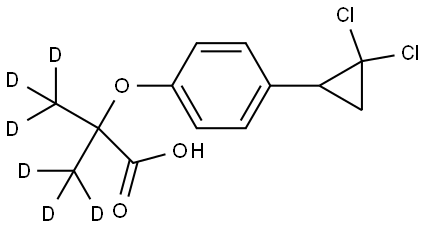Ciprofibrate-d
6 is intended for use as an internal standard for the quantification of ciprofibrate by GC- or LC-MS. Ciprofibrate is an agonist of peroxisome proliferator-activated receptor α (PPARα; EC
50 = 0.9 μM in a transactivation assay).
1 It is selective for PPARα over PPARγ and PPARδ at 300 μM.
2 Ciprofibrate (250 μM) induces cell cycle arrest at the G
2/M and S phases in Fao rat, but not HepG2 human, hepatocellular carcinoma cells.
3 It decreases fasting plasma levels of triglycerides and increases fasting plasma glucose levels in the apolipoprotein CIII transgenic mouse model of hypertriglyceridemia when administered at a dose of 10 mg/kg.
4 Formulations containing ciprofibrate have been used in the treatment of hypertriglyceridemia.
1. Quang, T.H., Ngan, N.T.T., Minh, C.V., et al. Anti-inflammatory and PPAR transactivational effects of secondary metabolites from the roots of Asarum sieboldii Bioorg. Med. Chem. Lett. 22(7),2527-2533(2012).
2. Forman, B.M., Chen, J., and Evans, R.M. Hypolipidemic drugs, polyunsaturated fatty acids, and eicosanoids are ligands for peroxisome proliferator-activated receptors α and δ Proc. Natl. Acad. Sci. USA 94(9),4312-4317(1997).
3. Passilly, P., Jannin, B., Hassell, S.J., et al. Human HepG2 and rat Fao hepatic-derived cell lines show different responses to ciprofibrate, a peroxisome proliferator: analysis by flow cytometry Exp. Cell. Res. 223(2),436-442(1996).
4. Bighetti, E.J.B., Patricio, P.R., Casquero, A.C., et al. Ciprofibrate increases cholesteryl ester transfer protein gene expression and the indirect reverse cholesterol transport to the liver Lipids Health Dis. 8,50(2009).
